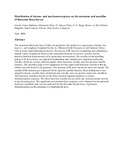Distribution of chemo- and mechanoreceptors on the antennae and maxillae of Busseola fusca larvae

View/
Date
2008Author
Gerald, Juma
Mathayo, Chimtawi
Peter, O. Ahuya
Peter, G. N. Njagi
Bruno, Le Rü
Gabriel, Magoma
Jean-François, Silvain
Paul-André, Calatayud
Type
ArticleLanguage
enMetadata
Show full item recordAbstract
The stem borer Busseola fusca (Fuller) (Lepidoptera: Noctuidae) is a major pest of maize, Zea mays L., and sorghum, Sorghum bicolor (L.) Moench (both Poaceae), in sub-Saharan Africa. Like in many other lepidopteran insects, the success of B. fusca in recognizing and colonizing a limited variety of plants is based on the interaction between its sensory systems and the physicochemical characteristics of its immediate environment. The sensilla on the maxillary galeae of B. fusca larvae are typical of Lepidoptera and comprise two uniporous styloconic sensilla, which are contact chemoreceptors, three basiconic sensilla, and two aporous sensilla chaetica. The maxillary palp is two-segmented and has eight small basiconic sensilla at the tip, which were also found to be gustatory. The antennae of B. fusca larvae are short and simple. The sensilla of the antenna are composed of two aporous sensilla chaetica, three multiporous cone-shaped basiconic sensilla, three small basiconic sensilla, and one aporous styloconic sensillum. The basiconic sensillum located on the third antennal segment displayed a contact chemoreception response. The other basiconic sensilla did not show any action potential activity in tip-recording tests. The significant and positive dose–response curve obtained for the antennal basiconic sensillum with sucrose indicated for the first time the presence of gustatory chemoreceptors on the antennae of a lepidopteran larva.
URI
http://onlinelibrary.wiley.com/doi/10.1111/j.1570-7458.2008.00673.x/abstracthttp://erepository.uonbi.ac.ke:8080/xmlui/handle/123456789/46663
Publisher
University of Nairobi, College of Health Sciences,
Subject
stem borerLepidoptera
Noctuidae
host-plant recognition
Zea mays
Poaceae
sensilla
contact chemoreceptors
Collections
- Faculty of Health Sciences (FHS) [10415]
